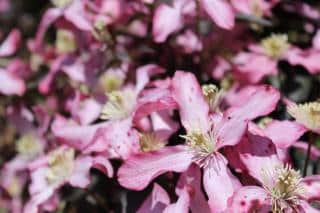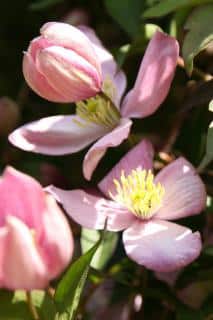

Clematis montana, or Mountain Clematis, is a vine that is simply beautiful.
Core Clematis montana facts
Name – Clematis montana
Family – Ranunculaceae
Type – vine
Height – 20 to 25 feet (6 to 8 m)
Exposure – full sun
Soil – deep and cool
Foliage – deciduous
Flowering – May
Described here are the right practices to bring out the best in your Clematis montana, a plant full of vigor bearing many flowers.
Clematis montana is planted indifferently in fall or in spring.
Clematis montana, like all other clematis flowers, loves being rooted in a shaded spot while the head basks in the sun.
Clematis requires some kind of structure to climb up along. Set it up at a distance of about 8 inches (20 cm) from the root collar.
Clematis montana is quite easily multiplied, either through layering of young stems or via cuttings.
Layering in spring, herbaceous cuttings end of spring, semi-hardened cuttings in summer, sowing in fall under a cold frame.
Growing clematis in a pot is as simple as A-B-C. Several Clematis montana varieties are well suited to container growing, although other Clematis varieties like Clematis alpina are better suited to it because of their slow growth.
 The right time to prune Clematis montana is after the blooming, most often during summer. But since it is rather hardy, pruning in fall is also possible.
The right time to prune Clematis montana is after the blooming, most often during summer. But since it is rather hardy, pruning in fall is also possible.
The more the pruning, the more it bears flowers!
Overwinter your mountain clematis simply with a layer of mulch along the roots. After all, another name for this vine is “Himalayan clematis”!
Watering Clematis montana is important in case of extended dry spell and/or intense heat.
Clematis can’t withstand drought, and neither can it cope with excess water that might make the roots rot away.
 Clematis montana ‘Alexander’
Clematis montana ‘Alexander’This is one of the Clematis montana cultivars that bears the largest flowers. These come in a cream-white color. If it doesn’t bear flowers immediately, don’t worry: it needs a few years before reaching the point of blooming.
Lilac violet-colored flowers, as its name shows. It is particularly interesting for the size of its flowers that can grow as large as saucers, over 6 inches (15 cm) across. It bears flowers all summer long.
Its blooming is immaculate white, simply magnificent against its gray-green leafage. It adapts particularly well to shaded areas.
Speed is what stands out about its growth, and its leafage and very interesting lilac pink flowers are remarkable. It’s among the clematis that have smaller flowers. There are several renowned cultivars: ‘Broughton Star’ and ‘Tetra Rose’, to name but two of them.
Its blooming comes late, but patience is rewarded when the superb fragrant white flowers appear: some say they have chocolatey smell!
Clematis montana grows best along a trellis or an arbor. On its own, the vine can’t rise up. Consider growing a few fragrant clematis on a pergola or around the posts of your carport: passing by the vine every day will give you a puff of joy! Three fragrant varieties stand out:
You can attach your clematis to a lattice to ensure it grows the way you hope it will as it develops!
Credits for images shared to Nature & Garden (all edits by Gaspard Lorthiois):
Two white clematis blooms by 阿橋 HQ under © CC BY-SA 2.0
Pink clematis montana bush by WillowGardeners under © CC BY 2.0
Newly opened Clematis montana blooms by Josh Egan-Wyer under © CC BY 2.0
C. montana flower buds (also on social media) by Rosalyn & Gaspard Lorthiois, own work
C. montana on brick wall (also on social media) by Rosalyn & Gaspard Lorthiois, own work
How big are mature montana roots, mine is about 15 years old and well established, I need to move it or at least disturb the root system while I redesign my garden
Hi Les, clematis roots don’t go too deep, at most a foot and a half or 45 cm for very old plants like yours. However, they do send roots far away, up to 8 feet or 2.5 meters. If you transplant it, be sure to try and cut a wide circle, at least 2 feet across (60 cm). Prune the vine itself back to reduce transplant shock. As for redesigning edges, it’s ok if a few of the longer roots are cut in the process. As long as it isn’t a strict circle cut very near the trunk, your clematis montana should be fine. At worst, you’ll have one year of more discreet blooming, but it should bounce back quickly after that.
Thank you Gaspard for your reply, with it being old and the gnarled trunk is about 2 and a half inches thick at the base feeding two 1 inch trunks at low level how far down can I prune and it still survive?
Well, it’s pretty good at bouncing back. However, I’d try to make sure the secondary trunks that are 1 inch across are at least three feet (1 m) long, with a couple tertiary branches at least 6 inches long (15 cm) at various spots along their length.
Thanks Gaspard. Very helpful and useful info. Will action immediately now I know what I am doing!!
I have a clematis Montana with long tenderals extending beyond the main plant.
Can I cut these back to conserve energy back into the main plant?
I am aware of how to prune after flowering.
Hello John, yes of course you can cut them back. Actually, pruning portions of the plant early on in undesired directions helps focus growth where you want it to grow. So feel free to prune these long extenders!
Just one word of caution, though. Check that these aren’t bearing the load of the plant, or the entire vine might collapse!